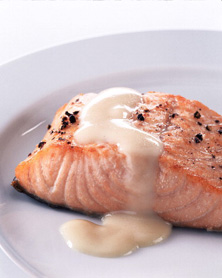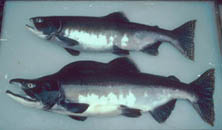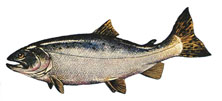Pink Salmon (Oncorhynchus gorbuscha)
- Pink salmon are abundant in Alaska; populations are generally healthy in the Pacific Northwest as well.
- The United States and Canada cooperate in the sustainable management of Pacific salmon through the Pacific Salmon Treaty.
- Pink salmon is low in sodium, a good source of omega-3 fatty acids, and a very good source of protein, niacin, vitamin B12, and selenium. For more information, see Nutrition Facts. (USDA)
- Commercial landings are worth about $50 million per year to fishermen in Alaska. Pink salmon is most frequently marketed as a canned product, and pink salmon roe (eggs) is much more highly valued than the flesh.
|
 |
 |
 |
 |
| Nutrition Facts |
| Servings 1 |
| Serving Weight
100g |
 |
| Amount Per Serving |
 |
| Calories 116 |
 |
| Total Fat |
3.45 g |
 |
| Total Saturated Fatty Acids |
0.558 g |
 |
| Carbohydrate |
0 g |
| Sugars |
0 g |
| Total Dietary
Fiber |
0 g |
 |
| Cholesterol |
52 mg |
 |
| Selenium |
44.6 mcg |
 |
| Sodium |
67 mg |
 |
| Protein |
19.94 g |
 |
|
 |
 A salmon seiner in southeast Alaska. Most pink salmon are harvested in the ocean by purse seines. A salmon seiner in southeast Alaska. Most pink salmon are harvested in the ocean by purse seines.
|
 |
Did you know?
Pink salmon is mostly sold canned.
Salmon have long been an important source of spiritual and physical sustenance for Northwest Indian tribes, and they are symbolically important to many other residents of the Northwest.
Salmon are affected by a wide variety of factors in the ocean and on land, including ocean and climatic conditions, dams, habitat loss, urbanization, agricultural and logging practices, water diversion, and predators (including humans).
|
|
| |
 |
|
Adult pink salmon. Maturing males develop a hump on their back, which is why they are often called "humpback" salmon.
|
 |
|
In the sea, pink salmon are steel blue to blue-green on the back, silver on the sides, and white on the belly.
|
|
Sustainability Status
Biomass: Unavailable*
Overfishing: N/A**
Overfished: N/A**
Fishing and habitat: Most pink salmon are harvested in the ocean by purse seines, with smaller commercial catches made by set and drift gill net and troll fisheries. Marine recreational fisheries primarily use troll gear. These fisheries generally operate in the water column with minimal impact on the bottom or other habitat.
Bycatch: Fisheries for pink salmon have some bycatch associated with them, primarily other Pacific salmon species. Management measures seek to minimize salmon bycatch and bycatch mortality.
Aquaculture: Because of their small size, relatively high abundance, and low, per-pound value, pink salmon are not currently used in traditional aquaculture. They are one of the primary species used in ocean ranching aquaculture, with contributions to commercial fisheries of 40 to 60 million fish each year.
*Unlike most groundfish stocks, biomass measurements are not used to describe the status of salmon stocks. Instead, stock status is usually described using measures of spawning escapement, productivity, and recruitment. However, annual estimates of abundance of year classes that will contribute to fisheries are used for management purposes.
**Overfishing criteria are not applicable because Council management actions have inconsequential impacts on pink salmon stocks.
|
Science and Management
The North Pacific Fishery Management Council manages the salmon fisheries in the exclusive economic zone (EEZ) off Alaska under the Fishery Management Plan for the Salmon Fisheries in the EEZ off the Coast of Alaska. The Salmon FMP allows a commercial troll fishery off Southeast Alaska and closes the remaining EEZ off Central and Western Alaska to commercial salmon fishing. The salmon FMP defers management of the commercial troll fishery in Southeast Alaska to the State of Alaska and, under the Pacific Salmon Treaty, the U.S.-Canada Pacific Salmon Commission. The Southeast Alaska troll fishery is a mixed-stock, mixed-species fishery that primarily targets Chinook and coho salmon, with pink, chum, and sockeye salmon taken incidentally.
The salmon fisheries in the EEZ off Washington, Oregon, and California are managed by the Pacific Fishery Management Council (PFMC) under the Pacific Coast Salmon Plan. A number of management controls are used to manage the ocean fisheries each season, including boundaries, seasons, quotas, minimum harvest lengths, fishing gear restrictions, and recreational daily bag limits. These controls vary depending on the number of salmon. The Pacific Council usually increases opportunity to harvest pink salmon in odd years when adult returns are greatest. Every year the PFMC follows a preseason process to develop recommendations for management of the ocean fisheries.
In 1985, the United States and Canada signed the Pacific Salmon Treaty (PST) to foster long-term benefits for salmon and to establish processes for the two countries to cooperate in the management, research, and enhancement of Pacific salmon stocks of mutual concern. Salmon originating in the lakes and streams in one area of one country often spend a significant part of their life cycle feeding, growing, and contributing to fisheries in the waters of other jurisdictions. These shared interests and responsibilities for salmon were recognized in the PST, and the Pacific Salmon Commission (PSC) was formed to implement the treaty and provide regulatory advice and recommendations to U.S. and Canadian management agencies that regulate salmon fisheries. In 1999, an amended agreement under the treaty implemented abundance-based management (rather than management based on negotiated catch ceilings), included habitat provisions, created the Transboundary Panel and the Committee on Scientific Cooperation, and established the Northern and Southern Restoration and Enhancement funds. The PST includes provisions for the harvest sharing of pink salmon stocks in the boundary area between British Columbia and Alaska, and the PSC manages fisheries for pink salmon in U.S. Convention waters north of 48 degrees North latitude to meet Fraser River natural spawning escapement and U.S./Canada allocation requirements.
|
Life History and Habitat
Life history, including information on the habitat, growth, feeding, and reproduction of a species, is important because it affects how a fishery is managed.
- Geographic range: From the Arctic coast in Alaska and territories in Canada to central California.
- Habitat: Pink salmon have a complex life cycle that spans a variety of freshwater and saltwater habitats. They are born in inland streams and rivers, migrate to coastal estuaries, and then disperse into ocean waters to grow. Once mature, they reverse their course, returning to freshwater to reproduce and die. Pink salmon require cool, clean water with appropriate depth, quantity and flow velocities, and upland and riparian (stream bank) vegetation to stabilize soil and provide shade. They must have clean gravel for spawning and egg-rearing, large woody debris to provide resting and hiding places, and varied channel forms.
- Life span: About 2 years. Because the pink salmon life cycle is so regular, essentially independent populations spawn in even and odd years. In the southern part of their range, odd year returns are dominant, and in some systems exclusive. Throughout most of Alaska, there is no distinct run dominance, but even year runs predominate in the northwestern part of Alaska.
- Food: Pink salmon generally feed on small crustaceans, zooplankton, swimming mollusks, and small fish.
- Growth rate: Rapid-in fact, pink salmon is among the fastest growing Pacific salmon species.
- Maximum size: The maximum size of pink salmon is about 2.5 feet. The maximum reported weight for pink salmon is about 15 pounds.
- Reaches reproductive maturity: Pink salmon reach reproductive maturity when they weigh about 2 to 5 pounds. After about 18 months in the ocean, maturing fish return to freshwater to spawn and die.
- Reproduction: Pink salmon have the lowest reproductive potential of Pacific salmon, averaging 1,200 to 1,900 eggs per female, and also some of the smallest eggs. The eggs are fertilized when they are deposited in the nests. Males compete with each other to breed with spawning females. Females remain on their redds (nests) one to two weeks after spawning, to protect the area from another female laying her eggs on top. Upon emergence, pink salmon fry migrate quickly to the sea and grow rapidly as they make extensive feeding migrations.
- Spawning season: From August to October.
- Spawning grounds: Pink salmon spawn closer to tidewater than most other Pacific salmon species, generally within 30 miles of a river mouth. In areas such as Southeast Alaska and Prince William Sound, the majority of the populations have significant components that spawn in the inter-tidal zone. However, some populations might migrate up to 310 miles upstream to spawn. Pink salmon usually spawn at depths of less than 1 foot to just over 3 feet. In general, they pick sites in gravel with relatively fast currents.
- Migrations: They are anadromous fish, which means that they migrate up rivers from the ocean to breed in freshwater. The incubating eggs, and resulting fry, spend the winter in the stream gravel and as soon as the yolk sac is absorbed, juveniles leave the spawning gravel and migrate rapidly to the ocean at about 0.0004 pounds in weight, or about half the weight of a paper clip.
- Predators: In freshwater, aquatic invertebrates, other fishes, especially sculpins, birds, and small mammals prey on pink salmon eggs, alevins, and fry. In the ocean, other fishes, including other Pacific salmon, and coastal seabirds prey on pink salmon fry and juveniles. Predators of adults include marine mammals, sharks, other fishes such as Pacific halibut, and humpback whales.
- Commercial or recreational interest: Both
- Distinguishing characteristics: Pink salmon can be distinguished from other Pacific salmon by the presence of large dark oval spots on the back and the entire caudal fin and their general coloration and form. In the sea, pink salmon are steel blue to blue-green on the back, silver on the sides, and white on the belly. Breeding males become dark on the back and red with brownish green blotches on the sides. Breeding females are similar but less distinctly colored. Maturing males also develop a hump on their back.
|
Role in the Ecosystem
In the ocean, pink salmon fry and juveniles are food for a host of other fishes, including other Pacific salmon, and coastal seabirds. Subadult and adult pink salmon are known to be eaten by 15 marine mammal species, sharks, other fishes such as Pacific halibut, and humpback whales. Because pink salmon are the most abundant salmon in the North Pacific, it is likely they comprise a significant portion of the salmonids eaten by marine mammals.
Pink salmon eggs, alevins, and fry in freshwater streams provide an important nutrient input and food source for aquatic invertebrates, other fishes, birds, and small mammals. Because pink salmon spawning populations often number in the hundreds of thousands, their carcasses also provide significant nutrient input into many coastal watersheds. Adult pink salmon in streams are major food sources for gulls, eagles, and other birds, along with bear, otter, mink, and other mammals, fishes, and aquatic invertebrates.
|
Additional Information
Market names: Pink or Humpback Salmon
Vernacular names: Humpy, Gorbusch, Haddo, Holia
|
Biomass
Biomass refers to the amount of pink salmon in the ocean. Biomass estimates are not available for pink salmon. Unlike most groundfish stocks, biomass metrics are not used to describe the status of salmon stocks. Instead, stock status is usually described using measures of spawning escapement, productivity, and recruitment. Information related to the status of stocks can be found on the websites listed at the bottom of this page.
Pink salmon are the most abundant Pacific salmon, contributing about 40% by weight and 60% in numbers of all salmon caught commercially in the North Pacific Ocean and adjacent waters. Pink salmon populations in Alaska are abundant, with historic record catches over the past decade, exceeding 100 million fish statewide in several years. Farther south, pink salmon populations may not be at record levels, but are generally healthy.
Landings
 Landings refer to the amount of catch that is brought to land. The majority of U.S. landings come from Alaska. Small numbers of pink salmon are also harvested off the West Coast, especially in odd-numbered years. Landings refer to the amount of catch that is brought to land. The majority of U.S. landings come from Alaska. Small numbers of pink salmon are also harvested off the West Coast, especially in odd-numbered years.
Note: Only domestic commercial landings are shown in the graph.
Biomass and Landings
Are landings and biomass related? Landings are dependent on biomass, management measures in the fishery, and fishing effort.
Data sources:
Landings from NMFS Annual Commercial Landings Statistics using "SALMON, PINK" as Species and "ALASKA" and "PACIFIC" as State
|
Important Dates
1977 – Pacific Council's (PFMC) first Salmon Fishery Management Plan (FMP) and Environmental Impact Statement (EIS) govern salmon season
1978 – New PFMC salmon FMP and EIS completely replace 1977 documents
1979 – North Pacific Fishery Management Council's (NPFMC) Alaska Salmon FMP is implemented
1984 – PFMC Salmon FMP comprehensively amended to implement the framework process for annual management
1985 – Pacific Salmon Treaty developed through cooperation of U.S. and Canadian governments, tribes, state governments, and sport and commercial fishing groups and implemented by the Pacific Salmon Commission
1990 – Alaska Salmon FMP revised, deferring management to the State of Alaska
1997 – Amendment 12 (PFMC) implements procedures governing retention of salmon bycatch in trawl nets and management objectives for ESA-listed salmon species
1999 – An agreement under the Pacific Coast Salmon Treaty creates the Transboundary Panel and Committee on Scientific Cooperation, includes habitat provisions, implements abundance-based management (rather than management based on negotiated catch ceilings), and establishes the Northern and Southern Restoration and Enhancement funds
2001 – Amendment 14 (PFMC) updates EIS and defines new requirements of the Sustainable Fisheries Act including Essential Fish Habitat (EFH), optimum yield, overfishing, and bycatch; also clarifies stocks managed and management objectives
|
Notes and Links
General Information:
NMFS Northwest Regional Office (NWR) - Salmon Populations
NMFS-NWR Endangered Species Act Information for Pink Salmon
Pacific Coast Salmon FMP Essential Fish Habitat Descriptions
NMFS Alaska Regional Office - Alaska Salmon Fisheries Management
Pacific Salmon Commission
NOAA-AFSC Genetic Structure of Auke Creek Pink Salmon
NOAA-AFSC Hatchery and Wild Salmon Interactions: Prince William Sound Pink Salmon
NOAA-AFSC Migration and Straying: Southeast Alaska Pink Salmon
NMFS Northwest Regional Office
NOAA-NWFSC Salmon Enhancement Program
Pacific Fishery Management Council Background on Salmon
Fishery Management:
FMP for the Salmon Fisheries in the EEZ off the Coast of Alaska
Pacific Coast Salmon Plan
Stock Assessments:
Pacific Fishery Management Council Review of 2006 Ocean Salmon Fisheries
|
| |
|



